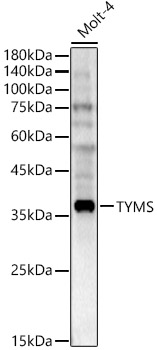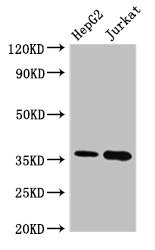![Thymidylate Synthase (5-FU Resistance Marker)(rTYMS/1884), CF405S conjugate, 0.1mg/mL [26628-22-8] Thymidylate Synthase (5-FU Resistance Marker)(rTYMS/1884), CF405S conjugate, 0.1mg/mL [26628-22-8]](https://biotium.com/wp-content/uploads/2021/02/view_image-812.jpeg)
Thymidylate Synthase (5-FU Resistance Marker)(rTYMS/1884), CF405S conjugate, 0.1mg/mL [26628-22-8]
BNC043812
ApplicationsFlow Cytometry, ImmunoFluorescence
Product group Antibodies
TargetTYMS
Overview
- SupplierBiotium
- Product NameThymidylate Synthase (5-FU Resistance Marker)(rTYMS/1884), CF405S conjugate, 0.1mg/mL [26628-22-8]
- Delivery Days Customer9
- ApplicationsFlow Cytometry, ImmunoFluorescence
- CertificationResearch Use Only
- ClonalityMonoclonal
- Clone IDrTYMS/1884
- Concentration0.1 mg/ml
- ConjugateOther Conjugate
- Gene ID7298
- Target nameTYMS
- Target descriptionthymidylate synthetase
- Target synonymsDKCD, HST422, TMS, TS, thymidylate synthase, TSase
- HostMouse
- IsotypeIgG1
- Protein IDP04818
- Protein NameThymidylate synthase
- Scientific DescriptionRecognizes a protein of 36 kDa, identified as Thymidylate Synthase (TS) (EC 2. 1. 1. 45). It converts deoxyuridine monophosphate (dUMP) to deoxythymidine monophosphate (dTMP), which is essential for DNA biosynthesis. TS is also a critical target for the fluoropyrimidines, an important group of antineoplastic drugs that are widely used in the treatment of solid tumors. Both 5-FU and fluorodeoxyuridine are converted in tumor cells to FdUMP which inactivates TS by formation of a ternary covalent complex in the presence of the folate cofactor 5, 10-methylenetetrahydrofolate. Expression of TS protein has been reported to associate with response to 5-fluorouracil (5-FU) in human colorectal, gastric, head and neck, and breast carcinomas. Primary antibodies are available purified, or with a selection of fluorescent CF® Dyes and other labels. CF® Dyes offer exceptional brightness and photostability. Note: Conjugates of blue fluorescent dyes like CF®405S and CF®405M are not recommended for detecting low abundance targets, because blue dyes have lower fluorescence and can give higher non-specific background than other dye colors.
- SourceAnimal
- Storage Instruction2°C to 8°C
- UNSPSC12352203







